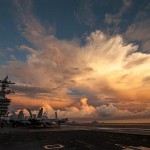Coincidence . . . or not

(Sep. 18, 2014) USS Carl Vinson (CVN 70) transits the Western Pacific Ocean. (U.S. Navy photo by Mass Comm Spec 2C John Philip Wagner, Jr.)
I searched the internet over the coming days, hopeful of a successful rescue report, but found no reference to the recent accident. My go-to military news source, Stars and Stripes had nothing. I did find many links to a tragic accident that occurred in September 2014. Curiously, the details of the collision, and the ships and squadrons involved were identical:
• Collision of two fighter jets, F-18 Hornets
• 250 miles west of Wake Island
• 1 pilot missing; one rescued, returned to USS Carl Vinson, in fair condition
• Search and rescue crews operating from guided missile destroyer USS Gridley, guided missile cruiser USS Bunker Hill, Helicopter Maritime Strike Squadron 73, and Helicopter Sea Combat Squad 15
• Neither plane found yet
What are the odds that all those details would be exactly the same? Was this a freakish coincidence or perhaps a reporter’s irresponsible error? I emailed my contact on Wake to see if they knew anything about it: he replied that he’d heard about it, Wake was not involved, and the Navy had called off the search for the missing pilot. I didn’t think to clarify the timing of the incident, and was just sorry to hear that the pilot was lost.
After the holidays I decided to search again for any updates on the December accident. The almost impossible similarities with the September 2014 incident still nagged, as did the lack of any other news coverage of the other one. Digging deeper, I did find another source on the December 17 incident: a link to a YouTube story by “Me_The People Perspective.” The video is dark with a few indiscernible light flashes and a woman’s voice essentially repeating the Voice Observer story with no additional details. I was unable to locate any information on either source or any way to contact the authors to follow up.
All of these searches continued to bring up the many news accounts of the tragic September 2014 collision. The San Diego-based aircraft carrier USS Carl Vison had left its home port on August 22, 2014 and was conducting exercises in the Western Pacific before continuing on to a long-term deployment in the Persian Gulf. The fatal collision occurred shortly after the F/A 18 Hornets launched from the carrier as one fighter came up under the bottom left rear of the other. (Some early reports stated in error that the collision occurred when the planes were in a holding pattern in preparation for landing.) When the higher jet caught fire and became uncontrollable, the pilot bailed out and was soon rescued. Both aircraft crashed into the ocean and were lost. Crews searched for the second pilot, Lt. Nathan Poloski, 26, of Lake Arrowhead, California, but his body was never found, only his cracked and battered helmet. I found many moving condolences and tributes to the young officer. In April 2015 the Navy issued its final report, ruling the fatal collision an accident.
Only after starting this blog post did it occur to me that I could quickly prove or disprove the December 2015 incident by finding out where the Vinson was deployed at that time. After a long deployment in the Gulf supporting strike operations in Iraq and Syria against the Islamic State, the Vinson returned home in June 2015. As of December 2015 the carrier was undergoing a planned maintenance period in its home port of San Diego, nowhere near the zone of coincidence.
I caution my history students to always evaluate the reliability and credibility of sources. We go online for information all the time now; just type in the keywords and hundreds of options pop up in less than a second. The internet is a goldmine for research, but search engines don’t filter for accuracy and reliability. Errors, irresponsible journalism, lazy duplication, and intentional misinformation float out there all the time with no red flags to mark them. Information flows so fast and in such volume that even in the unlikely event there was a retraction or correction you probably wouldn’t see it. It’s up to each of us to “watch what we eat.”
In the end, what really matters is the death of Lt. Poloski in September 2014. Among the many stories relating to the accident was one that carried a message written by Coronado cab driver Brian Blazevic to the commanding officer of the USS Carl Vinson. This part of his message resonates with me:
We’re just cab drivers, ordinary people living ordinary American lives, and as such we normally take for granted the safety and security we have. Those two things, safety and security, are the reason we can normally be oblivious of world events, and just live our safe little lives. But, with the loss of a brave pilot, it made us think for a little while that our cocoon of safety is actually guaranteed by people who volunteered to make sacrifices on our behalf. Sadly, somebody just made the ultimate sacrifice — for us. That means something. The loss wasn’t in vain. It wasn’t just a workplace accident. It was a sacrifice for others. I hope the family and people who knew the lost aviator fully understand that. If the loss is felt by a taxi driver, I believe it’s felt by a lot of people in America.

